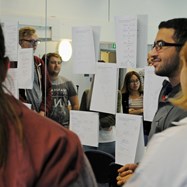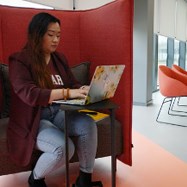Digitally enhanced learning at Russell Group universities
19 January 2022
What can students expect?
Campus life has returned to normal and all of our universities have resumed in-person teaching, which remains at the heart of the university experience. Students can expect seminars, small group classes and lab work to be taught in-person, alongside a range of extra-curricular activity, social events and support services on campus.
Our universities’ focus will always be on providing a high-quality teaching and learning experience for students, including by adapting to new technologies, pedagogic insights and opportunities as they arise, as well as learning from what works well.
For more than a decade, an element of digital learning has been used successfully to enhance teaching and learning and that will continue – for example with flipped lectures where students do background work ahead of in-person sessions. We also know many students welcome the additional flexibility and accessibility that digitally enhanced learning can provide.
What is ‘digitally enhanced’ or ‘hybrid’ learning?
Digitally enhanced learning involves enhancing in-person lectures, seminars, small group discussions, tutorials, lab work and workshops with technology, digital learning or high-quality online materials for self-study (see examples below).
Learning is personal and social, which is why in-person teaching is so important. And why our universities are looking to use digital to improve and not to replace on-campus teaching and learning.
In developing digitally enhanced learning our universities are reviewing how in-person or ‘contact hours’ are spent to maximise the benefits of this time for students. For example, exploring how they can use digital technology to deliver lectures and seminars more effectively or make them more interactive, such as through flipped teaching.
|
Flipped teaching or learning is where students engage with bespoke material online before the class, which can help introduce a concept and prepare the student to be able to use the in-person class time to delve into more depth, collaborate with other students, and interact with the lecturer. The result is that the time spent in the classroom – whether for a seminar, a lecture or a workshop – is much more active and effective. Flipped teaching has been adopted across the world and the educational benefits of this type of approach were already influencing how universities were shaping their approach before the pandemic. |
Traditional lectures – where a lecturer talks to a large group of students – only made up a small proportion of teaching and learning pre-pandemic and are likely feature much less in the future. This is because this format of teaching is far less interactive and personal than smaller group sessions and workshops.
Instead, Russell Group universities are reshaping their approach to encourage interaction, in-depth learning, and more active engagement by students so they’re able to drive their individual learning experience, with choice over the time, place and pace of their learning.
As well as increased student choice and flexible learning, a hybrid approach will help prepare graduates for an increasingly digital world that will demand agility and digital skills. More interactive learning through small group discussions and workshops also ensures that our students will be developing skills that are important in the workplace such as collaboration and communication skills.
What do students think?
Our universities work closely with students to understand their views on the aspects of learning and teaching that are working well and to identify areas where improvements can be made. The past year has been no exception to this; our universities have run multiple surveys and focus groups to understand students’ views on teaching and learning during the pandemic and what they want for the future.
Through this engagement, our universities have heard that students have valued the increased flexibility in the learning process, particularly from lectures being available online, but also from the increased presence of other online materials. This has allowed students to access their learning in ways and times that are most suitable for them. Having content available online has also increased the accessibility of materials and students have reported feeling less anxiety about missing course content, particularly for those students with medical conditions, certain disabilities, or caring responsibilities that can make attending lectures and classes at specific times difficult. Many students have expressed a desire for lectures to continue to be made available online for these reasons.
Student feedback has also confirmed our understanding that students really value in-person sessions, especially where these are in small groups, tutorials and workshops and also practical lab sessions and field work. This feedback reinforces the drive from our universities to focus in-person teaching and learning in these areas whilst using digital methods to enhance these sessions and ensure students get the most from them.
Is the shift to using digital materials in response to the pandemic?
The pandemic accelerated an existing trend towards digital materials and technology being used to enhance the university learning experience.
Universities were already making use of technology before the pandemic and changing many on-campus spaces to make them suitable for interactive teaching and learning. But the pandemic has undoubtedly been a catalyst for further change, and universities are working to ensure the aspects of teaching, learning and assessment that have been effective online during the pandemic can be retained and built on for the future for the benefit of all students.
|
At the University of York, the Archaeology department adopted a number of digital solutions to support their teaching and learning during the pandemic which are now being taken forward to enhance the future learning experience. This included a range of short explainer videos on themes such as ‘how to choose a dissertation subject’ and ‘identifying animal and human bones’. The department also arranged digital interviews with individuals working in the sector, including from commercial archaeology units, the Council of British Archaeology, and TV presenters. These were highly rated by students who not only got module content from different perspectives but also gained a better understanding of different career paths. The department has also been working hard to devise materials that meet accessibility challenges, for example making online lectures also available as podcasts and including audio descriptions of visual elements such as artifacts. |
|
The Geography department at the University of Liverpool, run a programme of practical classes for first year undergraduate students where, each week, students rotate around different practicals, collecting data, analysing and interpreting it. During the pandemic, the department adapted by filming, editing and narrating over 150 videos of lab measurements and over 500 microscope images, in the first semester alone. This will be taken forward in the 2021/22 academic year to support students in their learning, allowing them to refer to the videos during lab practicals as well as during independent study or when working toward their dissertation. This approach has also made the module more accessible to students, providing an opportunity for students who miss practical sessions for valid reasons, such as medical or caring responsibilities, to be able to go through practical work in their own time. |
Are universities moving courses online to reduce costs and contact hours?
The shift to digitally enhanced learning is not about saving money, but about enhancing the learning experience and making the teaching provision better. In fact, universities have invested millions of pounds to supplement in-person teaching with quality digital provision that is inclusive and accessible.
For example, since March 2020 the University of Manchester has invested approximately £3m into supporting digitally enhanced learning, including in equipment for staff (microphones, webcams, drawing tablets, etc), IT resource and technology, as well as expanding staff resource. This includes boosting its e-learning support team by around 20% with 24 new instructional designers and learning technologists.
Equally, there is no driver to reduce contact hours through digitally enhanced learning. Contact hours vary widely between disciplines and programme leaders will continue to choose the most appropriate approach for their discipline. However, what universities are doing with digitally learning is looking at how in-person contact hours are used, and exploring whether they can be more effectively delivered or made more interactive, to maximise the benefits that students get from this time and to ensure the best possible learning experience.
How is digital technology and learning being used to enhance in-person teaching at Russell Group universities?
Digital technology and learning are being used in a range of ways at Russell Group universities, from concise video-based packages designed to introduce concepts, to interactive seminars and hands-on digital activities like drawing tasks and digital lab work. The technologies used and how these work to support in-person session, will depend on the disciplines and programme of study. Some specific examples are outlined below.
|
The University of Warwick’s Medical School has developed a GP longitudinal virtual patient to mimic the long term and episodic interactions between a GP and their patient. Initially piloted in 2020 with one year group , the narrative has been developed to deliver this virtual learning experience to students through all four years of the course. The GP Longitudinal Virtual Patient follows the case of Clinton Jones across the curriculum. Students meet him for an initial ‘virtual consultation’ and are mailed his blood results to comment on. His story, which is grounded in the local area of Coventry, develops alongside the students helping them to apply their learning as they progress through their course. |
|
The University of Leeds has developed a virtual landscape for geology mapping. Originally created with disabled students in mind, this virtual landscape has now been rolled out to all students. The virtual landscape is a virtual reality environment designed to develop geologic mapping and field skills. The 3D topographic map are used to introduce students to the concept of reading the landscape from a map and The 3D geological maps allow students to observe how changes in the strike or dip of a rock change the outcrop pattern and can be used to encourage students to develop their own rules for how patterns change. The mapping landscapes are used before going on the first geological mapping field trip and as part of the university’s geological maps course. |
|
The Engineering department at the University of Edinburgh offers first year students a chance to use the university’s media platform to collaborate on project work. Students are asked to play with their role as “engineers in the making” and are challenged to deliver on four different group projects to develop their professional skills and engineering judgement. The students collaborate online to produce videos showing machines they have designed and built and in doing so demonstrate their ability to interact and coordinate project work digitally. Student group videos are openly licensed and published on the School of Engineering media channel for the world to see. The students’ work showcases a collaborative and creative learning activity which has been developed by the course team and builds on investment that has been made by the university in media platforms for learning. |
|
Imperial College London uses a number of Virtual Lab tools to complement the on-campus experience. For example, Labster, which gives students access to a realistic lab experience that will let them perform experiments and practice their skills in a fun and risk-free learning environment. Labster contains over 200 simulations, from microbiology to anatomy and chemistry. Virtual labs allow students to supplement in-person lab work with practice in their own time and at their own pace, with the online tools allowing them to repeat experiments as many times as they need. Academic staff are also able to track activity and assess students’ progress using interaction data, allowing them to deliver feedback and provide additional support to students when needed. |
Our briefing on digitally enhanced learning:
Digital approaches used to modernise and enhance teaching and learning at Russell Group Universities
-
Hamir Patel
hamir.patel@russellgroup.ac.uk
020 3816 1316
-
Hollie Chandler
Hollie.Chandler@russellgroup.ac.uk
020 3816 1307
 X
X


